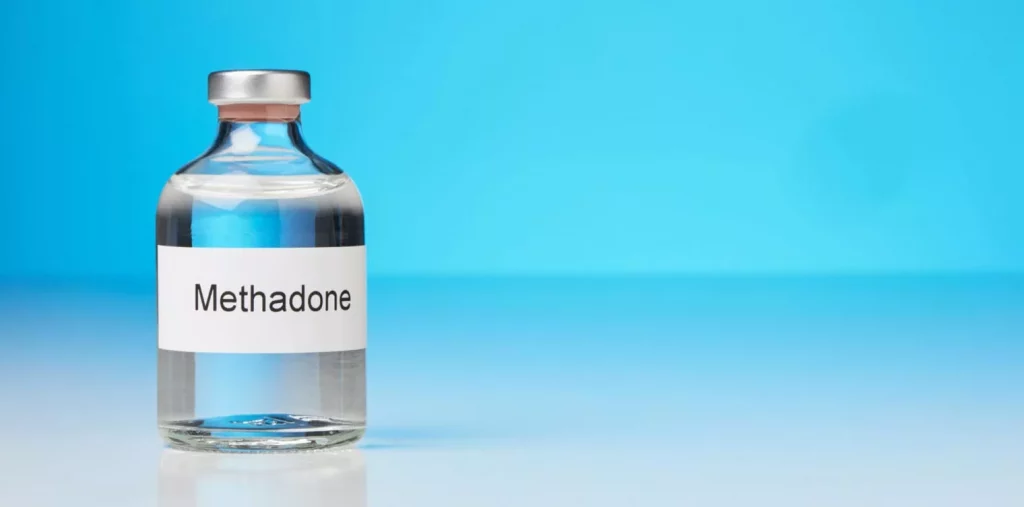What is Methadone?
Table of Contents
- What is Methadone?
- A Brief History of Methadone Medication Assisted Treatment
- Undergoing Methadone Maintenance Treatment
- What are the Ingredients of Methadone?
- How to Get on a Methadone Treatment Plan
- What is the Methadone Addiction Treatment Process?
- The Pros and Cons of Methadone Treatment
- Methadone Withdrawal and Abuse
- Frequently Asked Questions:
- Help for Methadone Addiction: Found Here
- Medically Reviewed By
Methadone is a medication that is commonly used to treat opioid addiction under the approval of the Food and Drug Administration (FDA). It is mainly used as medication-assisted treatment (MAT), as well as to help manage moderate to severe pain.
Methadone use is, for the most part, safe and effective, so long as a person is taking it as prescribed. This medication can help individuals prevent withdrawal during their recovery from opioid abuse, and more successfully achieve sobriety from other opioids, but can also require methadone addiction treatment as well.
This is because Methadone acts on the same opioid receptors as other opiate drugs, helping to make the body’s transition to sobriety less intense. It is mainly used for treating heroin addiction but has been found to be effective for treating addictions to various other opioids.
Of course, Methadone therapy is just one part of a comprehensive treatment plan. Many people who take methadone as a part of their substance abuse treatment process, will also partake in counseling and other behavioral therapies during recovery.
Whether you are using methadone as a treatment for other opioid dependence or looking to get clean from methadone itself, keep reading for more information!
A Brief History of Methadone Medication Assisted Treatment
The Opioid Epidemic is real. According to the Centers for Disease Control and Prevention, opioids, mainly synthetic opioids (not methadone) are currently the main driver of drug overdose deaths. More than 72% of opioid-involved overdose deaths involve these synthetic opioids.
Since 1999, opioid drugs have claimed the lives of more than 841,000 people. Due to this ‘epidemic’ status, history has tried to help prevent addiction, relapse, and deaths. One popular treatment is Methadone. First, let us learn some history on how methadone started and why.
Methadone was first created during World War II. German scientists in the 1930s were looking for a painkiller that had similar effects to morphine, but with fewer addictive properties. The United States received the right to use methadone towards the end of the war.
In the 1960s heroin addiction rates began to rise drastically. Medical professionals then revisited methadone’s uses and how it could help. Once they realized it could, the government finalized methadone regulations in 1972.
For over 50 years now, methadone has helped millions of people successfully to treat patients with drug addiction problems or opioid use disorders. Of course, this is a highly controlled process and one that does not come without its flaws.
Undergoing Methadone Maintenance Treatment
Methadone is a medication used in medication-assisted treatment (MAT). MAT is the use of medications in combination with counseling and behavioral therapy, to help sustain recovery against opioid use disorders (OUD).
The main goal of this treatment is to help people reduce or quit their use of heroin or other opiates/opioids. It is a safe and effective treatment that has many cases of success when taken as prescribed.
It has been proven to improve people’s lives, health, employment, and relationships. Methadone can also work in these ways:
- The proper dose allows patients to have a normal life without feeling “high.”
- Methadone has a gradual, long-lasting effect of 24-hours or more, which mitigates cravings for other opioids/opiates.
- It is taken once a day, so there is no need for injection needles and the risk of a disease like hepatitis or HIV.
Methadone works by changing how the brain and nervous system respond to pain. It will lessen the painful symptoms that opiate withdrawal can bring but will block the euphoric/addictive effects of opiates, opioids, and other drugs.
Agonism of the µ-opioid receptor is methadone’s mechanism of action for the treatment of pain. Methadone also acts as an agonist of κ- and σ-opioid receptors within the central and peripheral nervous systems.
Methadone targets the mu-opioid receptors (MORs). The Methadone half-life in an opioid-tolerant person is around 24 hours, which is longer than the half-life of heroin. In simple terms, this means it works as a full opioid agonist, meaning it fully activates the opioid receptors.
It blocks the properties opiates give off, making it easier to stay committed to treatment and fight off addiction. The treatment is offered in pill, tablet, and liquid forms and is taken once a day. The pain relief from a dose of methadone will last about four to eight hours.
It must be prescribed by a doctor, they will work with you to decide what is the best medication dosage for you. It is important to note that doses could change during treatment, but you should never stop taking methadone without first talking to your treatment providers.
What are the Ingredients of Methadone?
The medication’s active ingredients remain methadone hydrochloride. There is pure methadone and synthetic methadone. Pure methadone comes in the form of a white powder that can be dissolved into a solution.
As a synthetic opioid, methadone contains compounds created in a lab by using chemical reactions. It has similar characteristics to morphine, but with more mild effects so that it is not as addictive as its more potent counterpart.
However, a user can become addicted if they are taking methadone over the prescribed amount or for a longer period of time than directed. The main ingredient activates the opioid receptors in the brain, satisfying the need for opioids and withdrawal effects.
It accumulates in body tissues, being released as the blood concentration falls, buffering serum levels and lowering withdrawal and sedative effects. This is also what makes it so effective for pain relief.
How to Get on a Methadone Treatment Plan
There are some steps to first consider before finding out if methadone treatment is right for you. Let’s go over them:
1. Insurance
To be on a treatment plan there is varying insurance coverage available. The law requires insurance to cover addiction treatment, but if you don’t have it there are companies, plans, and programs that have individual policies to work with you.
The best step to take is to call your insurance company and the treatment center you want to attend for details. There may be certain criteria you must meet before treatment can be covered by your insurance provider.
2. Find a clinic
Although there are tons of clinics and facilities across the nation ready to help those with addiction or opiate problems. It is important to find the right one for you that also covers your insurance. Make sure to look closely at the clinic’s credentials.
When on methadone you will have to visit your clinic every day, so choosing a close location to where you live is important. If you have trouble finding a clinic or think you need something more proactive like a rehab facility, contact us at Find Addiction Rehabs. We are skilled in selecting the right treatment centers and programs for you.
3. Attend your sessions
After you find a clinic that best suits you, you will attend your first visit. They will let you know of everything you need to bring and how the program will be. The intake process will usually consist of your having a physical evaluation and drug screening.
During this process, you will be asked about your medical history and history of opioid/drug abuse. Paperwork will be completed and you will consult with an intake counselor to understand your needs for methadone.
After you go through this whole process it will be time to begin your first methadone treatment. This is actually an easy process. It is all about taking that first step and finding help where you need it.
Doctors will be happy to work with you and get you on a plan, just make sure you have these 3 steps figured out and that you are truly ready to change your life for the better. Now, let us take a look at what the treatment process will look like once you begin attending your sessions at the clinic or rehab facility.
What is the Methadone Addiction Treatment Process?
The medication will be taken under the supervision of a physician. The length of time one is on methadone depends on different factors. Specifically, how you are reacting to the treatment. Usually, the length of the treatment is recommended at a minimum of 12 months, with some patients requiring years of treatment.
Once a period of stability is reached, patients may be allowed to take methadone at home. While Methadone is a medication approved by the FDA, by law, it can only be dispensed through an opioid treatment program (OTP). It also must be certified by SAMHSA (Substance Abuse and Mental Health Services Administration).
An MAT program is an evidence-based treatment, which means when receiving this type of treatment (OTP) you must go to counseling to stay on it. This includes different forms of behavioral therapy. Other services may be required including; medical, vocational, educational, and other assessments.
The Pros and Cons of Methadone Treatment
With most treatments for drug/opiate abuse, there are pros and cons. Let us keep you informed on both.
The Pros:
The biggest pro of participating in this type of treatment is Methadone’s ability to help those in recovery by avoiding health risks and adverse side effects caused by withdrawal. Other benefits include:
- Reduction in infectious diseases that can come from opiate abuse
- Improvement in quality of life
- Higher chance of success in long-term recovery
- Reduction in criminal activity
- Improved social functioning
- Less harsh withdrawal symptoms
Another pro to taking methadone is if you are pregnant it is completely safe, even when breastfeeding. The fact that methadone must be part of an MAT program also helps patients by addressing other underlying mental and emotional problems.
This helps to provide a safe and supportive recovery environment that reduces the risk of relapse, reduces cravings and over-withdrawal symptoms, and puts you in a better aspect of life to cope.
The Cons:
The majority of cons of methadone treatment side effects are mild. A person on this treatment may experience things like a stomach ache, constipation, or sweating. There are also serious side effects that include:
- Sexual dysfunction
- Slowed breathing
- Nausea/vomiting
- Sleepiness and or restlessness
- Itchy skin
For the most part, these adverse side effects occur when taking Methadone without the supervision of your health providers, or combining this drug with other medications and substances that have not been approved by your medical team.
Methadone Withdrawal and Abuse
Methadone can also give some unpleasant withdrawal effects when abusing this medication. Individuals can develop a psychological and physical dependence on the drug. After all, because it is an opiate, it does present a risk of addiction.
If this drug abuse does occur there are some dangerous side effects of Methadone that can happen when not taking the drug safely, including:
- Respiratory depression
- Insomnia
- Sexual disinterest/dysfunction
- Swelling of limbs, feet, and hands
- Difficulty urinating
- Low blood pressure
- Extreme vomiting
- Irregular heartbeat
- Depression
While the withdrawal effects of Methadone will be at the worst during the first week, some symptoms can possibly last even longer than this. They are said to be very similar to flu-like symptoms.
Luckily, methadone does not recreate that same euphoric effect as heroin or morphine. It is designed to do the opposite and blocks those pleasures. For example, if someone who is using methadone attempts to do a drug like heroin, methadone will block those euphoric effects.
However, ironically it does have sedative effects that can lead to addiction and people abusing it in high doses. It is also very important to not use alcohol, benzodiazepines, or illicit opioids while on methadone.
It can be very dangerous causing serious respiratory issues and in some matters death. If you discontinue your methadone treatment and return to abusing opioids, or take too much Methadone in a short span of time, you are also at an increased risk for overdose.
Frequently Asked Questions:
What Are Some Alternative Medication Assisted Treatments to Taking Methadone?
There are similar alternatives to methadone if you find the treatment is not right for you.
- Buprenorphine and naloxone– Both are effective in replacement therapy for opioids. It comes in a variety of doses and has been shown to have fewer side effects. However, it is less effective as a replacement for long-duration opioids.
- Naltrexone HCL– This is similar to methadone in that it blocks the effects of other opioids/drugs on the brain. A drawback to choosing this treatment is a patient must stop using any opioids/drugs for at least seven days before starting it, meaning a hard road of withdrawal could occur.
- Non-medicinal alternatives– If you aren’t looking for medication to treat your opioid use disorder or are worried about becoming addicted, there are clinical therapy options like counseling and Cognitive Behavior Therapy. Other methods like acupuncture, massage, and herbal therapy could be an option but they are not backed by scientific knowledge as being an effective form of treatment.
What are the Differences Between Methadone Treatment and Buprenorphine Treatment?
- Methadone requires daily visits while in treatment, buprenorphine depends on the program enrolled. Normally, when it is prescribed it will be taken at home.
- Buprenorphine doses can differ and over time you may begin to take it every other day rather than every day.
- Over time, methadone may be allowed to be taken at home depending on a doctor’s recommendations.
Thankfully, there are tons of treatment options available for those looking to overcome opioid dependency. The best option to start treatment is to talk to your doctor or therapist and create a plan that fits you.
Methadone results will be considered successful when these criteria are met:
- Fewer experiences to no withdrawal symptoms and cravings
- No euphoric effects when taking an opioid drug
- Stops taking opioid drugs for 6-months or longer
Help for Methadone Addiction: Found Here
When properly regulated, Methadone is safe and it does work. A study done by UC San Francisco found that methadone maintenance is more effective in reducing heroin use among addicts than the typical 180-day detoxification program. Other research also found that methadone maintenance treatment has a success rate as high as 90%, that’s compared to patients who don’t use methadone as a treatment to combat opioid abuse disorder.
That being said, you may already know that methadone is effective in getting and keeping you off opiates purchased from the street, or even fentanyl addiction following surgery. But you may have been on methadone for years now, and want to know if getting off methadone is possible.
Rest assured that it is and that many successful clients of ours have asked the same question. Find Addiction Rehabs can help you find treatment options nationwide that will help you, regardless of current dosage, to quit methadone once and for all. Reach out now to find out more information and get on the path to a totally sober you!
Bryan was born in Philadelphia and remains an ardent supporter of Philadelphia sports. After attending FSU and FAU where he majored in writing, Bryan ventured out to follow in the footsteps of his idols, running straight into drug addiction. After being arrested by the President’s Secret Service, Bryan finally started to rebuild his life and beat that monkey off of his back through writing, playing music, and studying Buddhist philosophy.
Despite still having the occasional struggles with mental health, Bryan strives to be a little bit better a person each day. With the support and love from a loyal family, and kind-hearted and generous friends, Bryan tries to help people vanquish their own personal demons as he did and bring more love and beauty into a pessimistic world.





